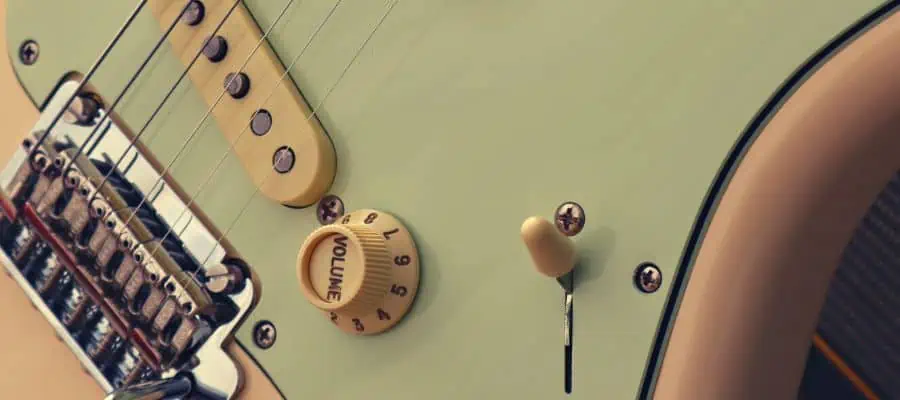Stratocasters and Telecaster are two of the most iconic electric guitars that shaped music history. Loved and used by guitarists across all genres, these guitars hit the sweet spot between design, materials, tonality, versatility, and playability. However, they feature unique characteristics that set them apart and make them sound quite different.
The reason why the Stratocasters and Telecasters have different sounds is related to their pickups, designs, and construction materials. Strats have a clearer, brighter, and cleaner sound compared to the darker sound of Telecasters with more bite and grit.
Stratocasters usually feature only single-coil pickups or a combination of humbucker and single-coils with tremolo bridges that provide a bright and balanced sound with enhanced sustain.
On the other hand, Telecasters are sonic chameleons with a twangy, darker, and articulate tone due to their dual single-coil pickups and fixed bridge.
So, let’s compare the two guitars, getting into more detail to see how these subtle differences play a significant role in the different tones of these guitars.
Pickups and Pickup Arrangement

The main reason behind the different tones of Strats and Teles is the pickups. While they have different pickups, providing different tonal qualities, the pickup arrangement is also quite different, giving different tonal characteristics.
- Starting with the pickup arrangements, Strats traditionally have three single-coil pickups in the bridge, middle, and neck positions. On the other side, Teles usually come with two single-coil pickups one in the bridge and the other on the neck position.
- The bridge pickups sound the hottest and brightest, while the neck pickups sound the warmest and cleanest. Strats also balance the two with the middle pickups, creating a different tonal versatility.
- Coming to the pickup choices, the Strat pickups have fewer coil windings than Tele pickups, leading to a clearer tone and lower output, compared to the Tele pickups with more windings, meaning a higher output and grittier tone.
- The Strat neck pickups come with thicker wires for a brighter tone, while the Telecaster neck pickups feature thinner wires, providing darker tones.
- Also, the Strat pickups all come uncovered for a more high-end emphasis. But, the Telecaster neck pickups have a metal cover to reduce the higher frequencies for a darker and warmer tone.
- The Stratocaster bridge pickups are mounted on plastic bases, giving them a cleaner tone with less twang compared to the Tele bridge pickups, which come on metal plates for a bass and low-mid focus and more twang.
So, the Stratocasters are perfect for blues, rock n’ roll, funk, and jazz, thanks to their bright tones and warmer-sounding neck pickups. On the other hand, Telecasters are more like sonic chameleons, which are used for almost every genre, from rock to country. Their extra bite on the bridge position provides great tones for heavier tones that need more punch and cut, while the overall twangy sound of Telecaster is commonly used for clean country tones and everything in the middle.
For high-gain tones, both guitars have unique models with humbucker designs, which can be great for genres like heavy metal.
Electronics and Controls

The electronics and controls of a guitar decide the sonic versatility as it gives you the parameters to adjust your tone. On the first look, Strat has a clear advantage as it comes with three pickups and more controls to play around with, allowing for more versatility.
- Stratocasters come with a 5-way pickup selector, while Tele has a 3-way pickup selector.
- Stratocasters have a master volume, bridge pickup tone, and neck-middle pickup tone controls, while Teles have a master volume and master tone controls.
As you see, Stratocasters have more control and potential for on-the-go adjustments, which can be interpreted as having more sonic versatility. That is partly true, as you can shape your sound quickly with these controls.
However, as said before, Telecasters are sonic chameleons, which respond better to different genres with adjustments from the pedalboard or amps.
Bridge And Hardware

The bridge design is also a factor in the tone as it plays a role in the sustain and twanginess of the sound. Stratocasters typically have a synchronized tremolo bridge, while Teles come with a string through a fixed bridge.
The tremolo bridge gives you the advantage of using the tremolo arm to create some cool pitch-shifting effects, which you don’t get with the Telecaster’s fixed bridge. However, Telecaster’s fixed bridge allows for enhanced sustain and a more twangy tone.
Design And Construction

Coming to the design, the first thing to notice is the different body shapes. While the body shape does not directly affect the tone, it does affect the playability, which affects the sound indirectly.
- The Stratocaster has a double-cutaway design, while the Telecaster has a single-cutaway design.
- Stratocasters come with the so-called elbow-cut, the contour on the top of the body, while Telecasters feature a flat top.
- Strats have a soft body edge, while Teles include hard edges.
So, Strats feel more comfortable to play, and thanks to the double-cutaway design, it makes the higher fret access easier. As mentioned before, these features do not affect the tone but the feel of the play, which indirectly plays a role in the final sound.
Conclusion
I must say that while writing this article, I took the traditional standard Fender Stratocaster and Telecaster models into account. Today, there are many different variations of both guitars that can create different sonic possibilities. There are Stratocasters and Telecasters with varying configurations of pickup bridge choices, as well as neck shapes and body designs.
In the end, the central role is played by the pickups, pickup configurations, electronics, and bridge. Features such as design and construction affect playability, which may also have an indirect effect on tone.
If you found this article useful, you may want to save this pin below to your Guitar board.

Recent Posts
When learning new songs have you noticed that some of the chord sequences sound really good? But when you tried to come up with your own chord sequence, or as we call it chord progression, you found...
Some guitarists insist on buying an expensive amplifier with their electric guitar. They assume that this is a must for every type of guitarist out there. However, in some situations, this isn’t...

